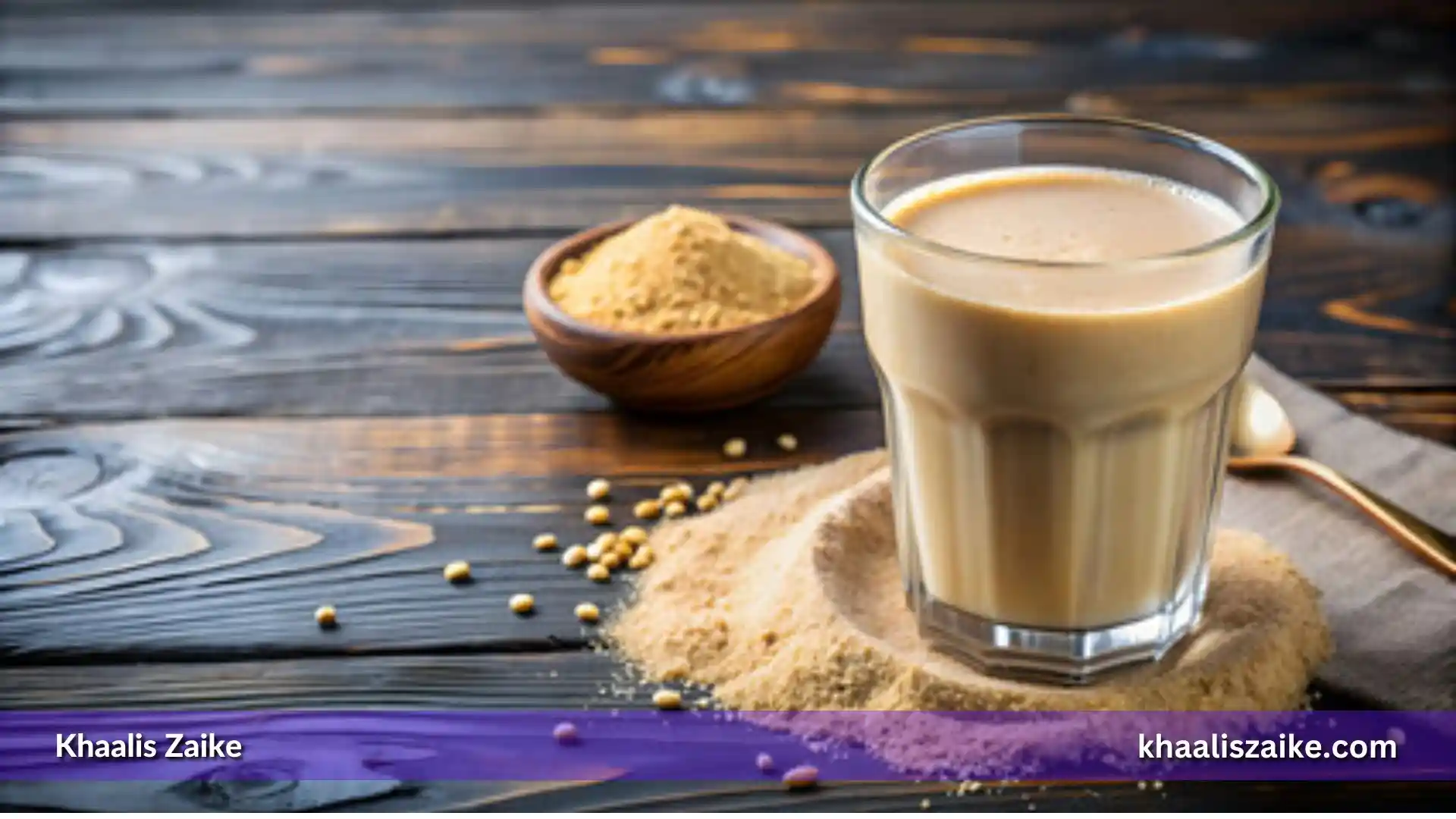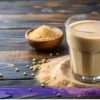
Sattu Benefits: 31 Amazing Sattu Health Benefits
Table of Contents
Sattu is not just a local ingredient but a nutritional powerhouse that has been a part of traditional Indian diets for generations. Primarily popular in Pakistan and India, due to myriad Sattu benefits this nutrient-rich flour is rapidly gaining attention worldwide. In this blog post, we will delve into the various Sattu benefits that make it a must-have for everyone looking for a balanced, healthy lifestyle.
What is Sattu?
Sattu is a flour made from roasted and ground pulses (usually chickpeas) and cereals. It’s a staple food in many parts of Pakistan, particularly in Karachi, Lahore, and Islamabad. Sattu is also consumed in Nepal, Tibet, and India.
Here’s a breakdown of its key characteristics:
- Made from Roasted Pulses and Cereals: The base of Sattu is typically roasted chickpeas (gram), although other pulses like barley, wheat, or even millets can be used. The roasting process enhances the flavor and shelf life of Sattu.
- Flour-like consistency: After grinding, Sattu has a coarse flour-like texture. This makes it versatile for incorporating into various dishes.
- Rich in Nutrients: Sattu is a nutritional powerhouse. Due to the roasting process, it retains a high concentration of protein, fiber, vitamins, and minerals.
Traditionally, Sattu benefits are the reasons for its popularity and was often consumed as a travel food or during hot weather. In recent times, Sattu has gained recognition as a potential “superfood” due to its impressive nutritional profile.
Sattu Powder Usage
Sattu, the versatile roasted chickpea flour, boasts a range of uses beyond just a health food. Here’s a glimpse into the culinary world of Sattu:
1. Refreshing Summer Drinks:
- Sattu Sharbat (Drink): The most popular use of Sattu is in the form of a refreshing beverage called Sattu ka Sharbat. It’s made by mixing Sattu powder with water, adding a pinch of salt, lemon juice, and your choice of flavorings like cumin powder, roasted cumin seeds, chopped cilantro, or even a hint of jaggery (unrefined cane sugar) for sweetness. This cool and hydrating drink is a staple in many parts of Pakistan and India during the hot summer months.
2. Savory Staples:
- Sattu Paratha: A popular flatbread recipe, Sattu parathas are made with kneaded dough incorporating Sattu flour. These parathas are delicious when paired with chutneys, pickles, or a simple raita (yogurt-based condiment).
- Sattu Roti: Similar to parathas, Sattu rotis are another flatbread option made with Sattu flour. They are a healthy and filling alternative to regular rotis made with wheat flour.
- Theplas: These flatbreads made with Sattu dough are often stuffed with various savory fillings like mashed potatoes or grated vegetables. Theplas are great for lunchboxes or as a quick and portable snack.
3. Innovative Culinary Delights:
- Sattu Porridge: A healthy and filling breakfast option, Sattu porridge is made by simmering Sattu flour in water or milk. You can customize it with nuts, seeds, chopped fruits, or a drizzle of honey for added flavor and texture.
- Sattu Laddoos: These energy balls made with Sattu flour, jaggery, ghee (clarified butter), and nuts are a delicious and nutritious sweet treat. They are perfect for satisfying sweet cravings or as a post-workout snack.
- Sattu Pancakes: A healthy twist on regular pancakes, Sattu pancakes are made with a batter combining Sattu flour, eggs, milk, and your favorite spices. They are a great way to incorporate Sattu into breakfast or brunch.
4. Beyond Food:
- Sattu Face Pack: Sattu powder, when mixed with yogurt or honey, can be used as a natural face pack. It’s believed to have exfoliating and cleansing properties, leaving the skin feeling soft and refreshed.
Remember:
These are just a few examples of how Sattu can be incorporated into your diet and daily routine resulting in lots of Sattu benefits. Explore various recipes and experiment with flavors to discover your own favorite ways to enjoy this versatile and nutritious ingredient.
Pro Tip: Yes, drinking Sattu daily is generally safe in moderation. It offers fiber, blood sugar regulation, and potential heart health benefits. However, listen to your body for any discomfort and consult a doctor if needed, especially with pre-existing conditions.
Sattu Nutritional Profile
Sattu isn’t just delicious; it’s a nutritional powerhouse packed with essential nutrients your body craves. Here’s a breakdown of what makes Sattu so beneficial:
- High Protein Content: Sattu boasts an impressive amount of protein, typically ranging from 20-25 grams per 100 grams. This makes it a valuable plant-based protein source, especially for vegetarians and vegans. The protein content can vary slightly depending on the specific pulse or grain used in its preparation.
- Fiber Rich: Sattu is a great source of dietary fiber, containing around 8-10 grams per 100 grams. Fiber is crucial for digestive health, promoting regularity and keeping you feeling fuller for longer.
- Healthy Fats: While not a high-fat food, Sattu contains a moderate amount of healthy fats, including monounsaturated and polyunsaturated fats. These fats are beneficial for heart health.
- Essential Vitamins and Minerals: Sattu is a treasure trove of essential vitamins and minerals. It’s a good source of iron, vital for red blood cell production and preventing anemia. Additionally, Sattu provides calcium for strong bones, magnesium for muscle function, and B vitamins for energy metabolism. It may also contain potassium, phosphorus, and zinc.
Sattu Ingredients
The beauty of Sattu lies in its simplicity. It requires minimal ingredients and offers a variety of health benefits. Here’s a breakdown of the typical Sattu ingredients:
- Primary Ingredient:
- Roasted Pulses: The foundation of Sattu is usually roasted chickpeas (gram). This roasted gram is sometimes referred to as “Bengal gram” These chickpeas are dried, roasted, and then ground into a flour-like consistency.
- Variations:
- Alternative Pulses: While gram is the most common, other roasted pulses can be used to make Sattu. These may include lentils, peas, or even moth beans.
- Combination with Cereals: In some regions, Sattu may incorporate roasted cereals alongside the roasted pulses. Barley, wheat, or even millets can be included in the mix.
Here’s a quick summary:
- Standard Sattu: Made from roasted chickpeas (gram) only.
- Variations: Made from roasted lentils, peas, moth beans, or a combination of roasted pulses and cereals like barley, wheat, or millets.pen_spark
Calorie Content of Sattu
Sattu is a good source of energy without being overly high in calories. A 100-gram serving of Sattu typically contains around 395-410 calories. This can vary slightly depending on the specific ingredients and processing methods.
How is Sattu Made
Sattu is a traditional food, and the process for making it can vary slightly depending on the region and equipment available. Here’s a general overview of the steps involved:
- Soaking: The process typically starts with soaking the chosen pulses, usually chickpeas (gram), overnight in water. This helps soften the beans and makes them easier to roast.
- Drying: After soaking, the chickpeas are spread out in a single layer on a clean surface and left to dry completely. This can be done in the sun for several hours or using a dehydrator.
- Roasting: Once thoroughly dry, the chickpeas are roasted. Traditional methods involve dry roasting in a hot pan over low heat or using a sand roasting technique. Modern methods may utilize an oven or an electric roaster. Roasting enhances the flavor and aroma of the Sattu and extends its shelf life.
- Cooling: After roasting, the roasted chickpeas are allowed to cool completely.
- Grinding: The cooled chickpeas are then ground into a fine powder using a mortar and pestle, a traditional grinding stone (chakki), a food processor, or a powerful blender. The goal is to achieve a smooth, flour-like consistency with minimal coarse particles.
- Sifting (Optional): Some recipes recommend sifting the ground Sattu powder to remove any larger pieces or chickpea skins. This step is optional and depends on your desired texture preference.
Additional Notes:
- Spices: In some variations, roasted cumin seeds or other spices may be added along with the chickpeas during the grinding stage for an extra flavor boost.
- Pre-Roasted Chickpeas: If you don’t have time to soak and roast your own chickpeas, you can use pre-roasted chickpeas (often available in Indian grocery stores) to expedite the process. Simply grind them into a powder following steps 4 and 5.
The resulting Sattu powder is a versatile ingredient that can be stored in an airtight container in a cool, dry place for several months.
#31 Eating Sattu Benefits For Health
Here are the top Sattu benefits and side effects
Health Benefits of Sattu Drink
Sattu, a humble flour made from roasted chickpeas, has been a staple food in many parts of Pakistan and India for centuries. Apart from its nutritional value, Sattu is also known for its cooling properties, making it a popular choice during the hot summer months.
1. Sattu Drink Benefits:
- Traditional Belief: Traditionally, Sattu has been consumed as a cooling food, especially during hot summers. It’s believed to help lower body temperature and combat the effects of heat stress.
- Potential Mechanisms: While the exact mechanisms behind Sattu’s cooling effect are not fully understood, there are a few possible explanations:
- High Water Content: Sattu is typically mixed with water to create a refreshing drink (Sattu sharbat). This hydration can help cool the body from within.
- Electrolyte Replenishment: Sattu contains electrolytes like potassium and magnesium, which are lost through sweat during hot weather. Replenishing these electrolytes can help prevent dehydration and maintain body temperature regulation.
- Digestive Support: Sattu’s high fiber content promotes digestion and helps prevent constipation. Smooth digestion can contribute to overall well-being and may reduce feelings of sluggishness or discomfort associated with hot weather.
2. Sattu Ka Sharbat:
- Popular Drink: Sattu ka sharbat (Sattu drink) is a popular and refreshing beverage made from Sattu powder, water, and various flavorings. It’s a common sight in India during the summer months.
- Easy to Prepare: Sattu ka sharbat is simple to prepare. Mix Sattu powder with water, add a pinch of salt, lemon juice, and other spices like cumin powder, roasted cumin seeds, and chopped cilantro for a flavorful and refreshing drink.
- Customizable Flavors: You can customize the taste of Sattu ka sharbat by adding different flavors. Popular additions include ginger, mint leaves, or even a touch of jaggery (unrefined cane sugar) for a hint of sweetness.
Incorporating Sattu for Cooling Benefits:
- Regular Consumption: Drink Sattu ka sharbat regularly during hot weather to stay hydrated and cool. Carry a reusable water bottle and make a batch at home to have it on hand throughout the day.
- Stay Hydrated: In addition to Sattu ka sharbat, make sure to drink plenty of water throughout the day to stay hydrated and support the cooling effects of Sattu.
- Avoid Excessive Heat Exposure: While Sattu can help, it’s important to practice sun safety and avoid excessive exposure to direct sunlight and heat. Seek shade, wear protective clothing, and stay cool in air-conditioned spaces when possible.
Sattu is not just a nutritious and versatile food; it’s also a natural coolant that can help you beat the heat. By incorporating Sattu ka sharbat into your diet and following sun safety practices, you can stay hydrated, cool, and refreshed during the hot summer months. Remember, a healthy body is a cool body, and Sattu can be a valuable ally in achieving that!
Digestive Benefits of Sattu
Sattu isn’t just a tasty and versatile ingredient; it’s a champion for your digestive health. Here’s a deep dive into how Sattu can benefit your digestive system:
3. Sattu Benefits As Having High Fiber Content:
- Fiber Powerhouse: Sattu boasts an impressive amount of dietary fiber, typically around 8-10 grams per 100 grams. This fiber acts like a broom in your digestive system, adding bulk to stool and promoting its smooth passage.
- Regularity Made Easy: By adding bulk and softening stool, the fiber in Sattu helps regulate bowel movements and prevents constipation. This can be particularly beneficial for those who experience occasional constipation or sluggish digestion.
- Prevents Diverticulosis: Fiber also helps keep your digestive system healthy by preventing diverticulosis, a condition where pouches form in the lining of the colon.
4. Sattu Benefits For Prebiotic Power:
- Nourishing Good Bacteria: Sattu may contain prebiotics, a type of non-digestible fiber that acts as food for the good bacteria in your gut. These good bacteria play a crucial role in maintaining a healthy gut microbiome, which is essential for optimal digestion, immune function, and overall well-being.
- Improved Nutrient Absorption: A healthy gut microbiome with a good balance of bacteria allows for better absorption of nutrients from your food. This ensures your body gets the essential vitamins, minerals, and other nutrients it needs to function properly.
- Reduced Inflammation: A balanced gut microbiome can help reduce inflammation in the digestive tract, which can contribute to various digestive issues like IBS (irritable bowel syndrome).
5. Sattu Benefits As Gentle on the Stomach:
- Soothing for Sensitive Systems: Sattu is a relatively bland food and is generally well-tolerated by most people. This makes it a good choice for those with sensitive stomachs or digestive conditions that require a bland diet.
- Reduced Gas and Bloating: Unlike some other legumes, Sattu is less likely to cause gas and bloating. This is because the roasting process during Sattu preparation can break down some of the complex sugars that can contribute to these issues.
6. Sattu Benefits For Aids in Detoxification:
- Fiber’s Cleansing Power: The high fiber content in Sattu helps to keep things moving through your digestive system efficiently. This can help eliminate waste products and toxins from the body, promoting overall digestive health.
Incorporating Sattu for Digestive Benefits:
- Start Slow: If you’re new to Sattu, it’s best to introduce it gradually into your diet to avoid any digestive discomfort. Start with a small amount and increase gradually as your body adjusts.
- Hydration is Key: Fiber works best when there’s sufficient water in your system. Make sure to drink plenty of water throughout the day when consuming Sattu to reap its full digestive benefits.
- Variety is Key: Explore different ways to incorporate Sattu into your diet. Try Sattu sharbat (a refreshing drink), porridge, or even flatbreads (parathas) to keep things interesting and enjoy the digestive benefits of Sattu in various forms.
By incorporating Sattu into your diet and supporting its benefits with good hydration practices, you can experience high Sattu benefits including a smoother, more comfortable digestive journey. Remember, a healthy gut is a happy gut, and Sattu can be a valuable ally in achieving just that!
Benefits Of Sattu Weight Loss
Sattu, the humble roasted chickpea flour, isn’t just delicious and versatile; it may also be a valuable tool in your weight management journey. Here’s how Sattu can potentially support your weight loss goals:
7. Sattu Benefits As Satiety and Reduces Cravings:
- Fiber Powerhouse: Sattu boasts a significant amount of dietary fiber, typically around 8-10 grams per 100 grams. This fiber keeps you feeling full for longer, reducing cravings and helping you manage calorie intake.
- Sustained Energy Release: Packed with complex carbohydrates, Sattu provides a slow and steady release of energy throughout the day. This prevents energy crashes that can lead to overeating and unhealthy snacking.
8. Sattu Benefits For Regulating Blood Sugar:
- Low Glycemic Index (GI): Sattu is believed to have a low glycemic index (GI). This means it causes a gradual rise in blood sugar levels rather than a spike. This helps control cravings and prevents blood sugar fluctuations associated with weight gain.
9. Sattu Benefits As Support For Healthy Digestion:
- Improved Nutrient Absorption: A healthy gut with a good balance of bacteria, potentially promoted by Sattu’s prebiotic properties, allows for better absorption of nutrients from your food. This can help you feel satisfied with fewer calories.
- Reduced Bloating: Unlike some other legumes, Sattu is less likely to cause bloating. This can contribute to a feeling of lightness and may help you feel more comfortable managing your weight.
10. Sattu Benefits For Managing Appetite:
- Reduced Calorie Intake: By promoting satiety, regulating blood sugar, and supporting healthy digestion, Sattu may help you manage your appetite and reduce overall calorie intake, potentially leading to weight loss.
Incorporating Sattu for Weight Management:
- Smart Swaps: Consider replacing high-calorie, processed snacks with Sattu-based options like roasted Sattu flour or Sattu bars.
- Breakfast Powerhouse: Start your day with a filling Sattu porridge or smoothie to keep you feeling full until lunchtime.
- Portion Control: While Sattu is beneficial, it still contains calories. Practice mindful eating and portion control when incorporating Sattu into your diet.
- Combine with Exercise: Remember, a healthy diet combined with regular exercise is the most effective strategy for weight loss. Sattu can be a valuable addition to your weight management plan, but it’s not a magic bullet.
Important Note:
While Sattu has potential benefits for weight management, consulting with a registered dietitian or healthcare professional is crucial for creating a personalized weight loss plan that aligns with your specific needs and health goals. They can help you determine the appropriate amount of Sattu to incorporate into your diet and ensure it complements your overall weight management strategy.
Sattu Benefits for Blood Sugar Management
Sattu, the versatile roasted chickpea flour, has gained recognition for its impressive nutritional profile. But beyond its general health benefits, Sattu may hold promise for those managing blood sugar levels. Here’s how Sattu can potentially be a friend to your blood sugar:
11. Sattu Benefits As Low Glycemic Index (GI):
- Gradual Sugar Release: Unlike refined carbohydrates, Sattu is believed to have a low glycemic index (GI). This means that when you consume Sattu, it causes a slower and more gradual rise in blood sugar levels compared to high-GI foods.
- Reduced Blood Sugar Spikes: This gradual rise in blood sugar is crucial for people managing conditions like diabetes, as it helps prevent the sharp spikes and crashes that can be detrimental.
12. Sattu Benefits For Blood Sugar Regulation:
- Slows Down Digestion: The high fiber content in Sattu, around 8-10 grams per 100 grams, plays a key role in blood sugar regulation. Fiber helps slow down the absorption of sugar from the intestines into the bloodstream, contributing to a more controlled and balanced rise in blood sugar levels.
13. Sattu Benefits For Insulin Sensitivity:
- Early Research: Some early research suggests that Sattu may improve insulin sensitivity. Insulin is a hormone that helps your cells absorb sugar from the bloodstream. Improved insulin sensitivity can lead to better blood sugar control. However, more research is needed to confirm this benefit.
Important Considerations:
- Not a Substitute for Medication: It’s crucial to understand that Sattu is not a replacement for medication prescribed by your doctor for diabetes or other blood sugar management needs. Always prioritize your doctor’s recommendations and consult them before making any significant dietary changes.
- Monitor Blood Sugar: If you are incorporating Sattu into your diet for blood sugar management, it’s essential to monitor your blood sugar levels regularly. This will help you understand how Sattu affects you individually and adjust your diet or medication as needed.
Incorporating Sattu for Blood Sugar Support:
- Smart Swaps: Consider replacing high-glycemic index foods like white bread or refined pasta with Sattu-based options like Sattu rotis (flatbreads) or porridge.
- Portion Control: While Sattu offers potential benefits, it still contains carbohydrates. Practice mindful eating and portion control to ensure your overall carbohydrate intake aligns with your blood sugar management goals.
- Consult a Healthcare Professional: A registered dietitian or healthcare professional can guide you on incorporating Sattu into your diet in a way that complements your existing blood sugar management plan and medication routine.
Remember:
Sattu may be a valuable addition to your blood sugar management journey, but it’s not a standalone solution. Always prioritize your doctor’s advice and combine Sattu with a healthy diet and regular exercise for optimal blood sugar control.
Sattu Benefits For Lowering Cholesterol
Sattu, the humble roasted chickpea flour, isn’t just a delicious and versatile food; it may also be a valuable ally in your fight against high cholesterol. Here’s how Sattu can potentially help lower your cholesterol levels:
14. Sattu Benefits As Fiber’s Cholesterol-Lowering Power:
- Fiber Binds Cholesterol: The high fiber content in Sattu, around 8-10 grams per 100 grams, plays a crucial role in cholesterol management. Fiber binds to cholesterol in the digestive system, preventing its absorption into the bloodstream and promoting its elimination from the body.
- Focus on LDL (Bad) Cholesterol: The fiber in Sattu may be particularly effective in reducing LDL (low-density lipoprotein) cholesterol, often referred to as “bad” cholesterol. LDL cholesterol contributes to plaque buildup in arteries, increasing the risk of heart disease.
Important Considerations:
- Not a Substitute for Medication: It’s crucial to understand that Sattu is not a replacement for medication prescribed by your doctor for high cholesterol or other heart-related conditions. Always prioritize your doctor’s recommendations and consult them before making any significant dietary changes.
- Lifestyle Modifications Key: A healthy diet rich in fiber like Sattu is just one piece of the puzzle. Managing cholesterol also involves maintaining a healthy weight, engaging in regular exercise, and managing stress.
Incorporating Sattu for Cholesterol Management:
- Smart Swaps: Consider replacing high-fat, cholesterol-laden foods with Sattu-based options. Swap out fried foods for Sattu parathas (flatbreads) or incorporate Sattu into salads for a fiber boost.
- Part of a Balanced Diet: Ensure your overall diet is rich in fruits, vegetables, whole grains, and lean protein alongside Sattu for a well-rounded approach to cholesterol management.
- Consult a Healthcare Professional: A registered dietitian or healthcare professional can guide you on incorporating Sattu into your diet in a way that complements your existing cholesterol management plan and medication routine.
Remember:
Sattu can be a valuable addition to your cholesterol management journey, but it’s not a magic bullet. Always prioritize your doctor’s advice and combine Sattu with a healthy lifestyle for optimal heart health.
Sattu Benefits For Long-Lasting Energy
Sattu, the unassuming roasted chickpea flour, packs a powerful punch when it comes to boosting your energy levels. Unlike sugary snacks or processed foods that provide a quick but fleeting energy burst, Sattu offers sustained energy throughout the day. Here’s how:
15. Sattu Benefits As Having Complex Carbohydrates:
- Slow and Steady Release: Unlike simple carbohydrates found in sugary drinks and refined grains, Sattu is rich in complex carbohydrates. These complex carbs are broken down by your body gradually, releasing energy at a slower and more consistent pace. This prevents the energy crashes often associated with sugary foods and keeps you feeling energized for longer.
16. Sattu Benefits As Combats Fatigue with Iron:
- Iron Deficiency and Fatigue: Iron deficiency is a common cause of fatigue and tiredness. Sattu is a good source of iron, which helps transport oxygen throughout your body, delivering it to your cells for energy production. By increasing your iron intake, Sattu can help combat fatigue and leave you feeling more energized.
17. Sattu Benefits As Keeping You Feeling Fuller:
- Fiber’s Satiety Power: Sattu boasts a significant amount of dietary fiber, typically around 8-10 grams per 100 grams. This fiber keeps you feeling full for longer, preventing dips in blood sugar that can contribute to fatigue and sluggishness.
18. Sattu Benefits As Sustainable Energy Source:
- Balanced Nutrient Profile: Sattu is not just a source of carbs and fiber; it also contains protein, healthy fats, and essential vitamins and minerals. This balanced nutrient profile provides your body with the fuel it needs for sustained energy production.
Incorporating Sattu for Long-Lasting Energy:
- Start Your Day Right: Fuel your mornings with a Sattu porridge or smoothie. This provides your body with sustained energy to tackle the day.
- Mid-Day Pick-Me-Up: Ditch sugary snacks and choose a healthy Sattu bar or roasted Sattu flour for a natural energy boost.
- Post-Workout Refueling: Sattu’s combination of protein and carbs makes it a great choice for post-workout recovery. Consider a Sattu drink or a light Sattu-based meal to replenish your energy stores.
Remember:
While Sattu is a great source of sustained energy, a healthy lifestyle plays a crucial role. Ensure you get enough sleep, manage stress effectively, and stay hydrated throughout the day for optimal energy levels.
Sattu Benefits For Heart
Sattu, the humble roasted chickpea flour, has a surprising amount to offer when it comes to protecting your heart health. Here’s a deeper dive into how Sattu can be a champion for your cardiovascular system:
19. Sattu Benefits in Cholesterol Control with Fiber:
- Fiber’s Binding Power: The high fiber content in Sattu, around 8-10 grams per 100 grams, plays a starring role. This fiber acts like a sponge in your digestive system, binding to cholesterol and preventing its absorption into the bloodstream. This helps lower your LDL (low-density lipoprotein) cholesterol, often referred to as “bad” cholesterol. LDL cholesterol contributes to plaque buildup in arteries, a significant risk factor for heart disease.
20. Sattu Benefits in Potential HDL (Good) Cholesterol Boost:
- Early Research Promise: While more research is needed, some early studies suggest that Sattu may help maintain healthy levels of HDL (high-density lipoprotein) cholesterol, the “good” cholesterol. HDL cholesterol acts like a scavenger, removing LDL cholesterol from the arteries and promoting its elimination from the body. This can contribute to a healthier cardiovascular system.
21. Sattu Benefits in Blood Pressure Support with Potassium:
- Potassium Powerhouse: Sattu is a good source of potassium, a mineral that helps regulate blood pressure. High blood pressure is a major risk factor for heart disease. By potentially helping to regulate blood pressure, Sattu can contribute to a healthier heart.
22. Sattu Benefits in Heart-Healthy Lifestyle Support:
- Combined Benefits: The combination of Sattu’s fiber content, potential HDL cholesterol support, and potassium for blood pressure regulation can work together to create a heart-healthy foundation.
Important Considerations:
- Not a Substitute for Medication: Sattu is not a replacement for medication prescribed by your doctor for high cholesterol, high blood pressure, or other heart conditions. Always prioritize your doctor’s recommendations and consult them before making any significant dietary changes.
- Lifestyle Matters: A healthy diet rich in fiber like Sattu is just one piece of the puzzle. Managing heart health also involves maintaining a healthy weight, engaging in regular exercise, managing stress, and not smoking.
Incorporating Sattu for a Healthy Heart:
- Smart Swaps: Replace high-fat, cholesterol-laden foods with Sattu-based options. Swap out fried foods for Sattu parathas (flatbreads) or incorporate Sattu into salads for a fiber and protein boost.
- Part of a Balanced Diet: Ensure your overall diet is rich in fruits, vegetables, whole grains, and lean protein alongside Sattu for a well-rounded approach to heart health.
- Consult a Healthcare Professional: A registered dietitian or healthcare professional can guide you on incorporating Sattu into your diet in a way that complements your existing heart health plan and medication routine.
Remember:
Sattu can be a valuable addition to your heart health journey, but it’s not a magic bullet. Always prioritize your doctor’s advice and combine Sattu with a healthy lifestyle for optimal heart health.
Sattu Benefits For Men’s Health
While Sattu offers a range of health benefits for everyone, some aspects may be particularly interesting for men. Here’s a closer look at how Sattu can be beneficial for men’s health:
23. Sattu Benefits for Energy and Stamina:
- Sustained Energy Release: Men often have active lifestyles and require consistent energy throughout the day. Sattu’s richness in complex carbohydrates provides a slow and steady release of energy, unlike sugary snacks that offer a quick but fleeting boost. This can help men maintain energy levels during work, workouts, or any physical activity.
- Combating Fatigue: Iron deficiency is a common cause of fatigue, and men are more susceptible to it due to menstruation not being a factor. Sattu is a good source of iron, which helps transport oxygen throughout the body, reducing fatigue and leaving men feeling more energized.
24. Sattu Benefits For Supporting Muscle Building and Maintenance:
- Plant-Based Protein Powerhouse: Sattu is a valuable plant-based protein source, containing around 20-25 grams per 100 grams. Protein is essential for building and repairing muscle tissue, crucial for men looking to maintain or build muscle mass.
- Improved Recovery: After exercise, muscle tissue requires repair and rebuilding. Sattu’s protein content, along with its potential for sustained energy, can contribute to a healthy post-workout recovery process.
Incorporating Sattu into a Man’s Diet:
- Post-Workout Recovery: Consider a Sattu smoothie or a light Sattu-based meal after workouts to replenish energy stores and support muscle recovery.
- Energy Boosting Snacks: Ditch sugary snacks and choose roasted Sattu flour or Sattu bars for a natural and sustained energy boost throughout the day.
- Versatile Ingredient: Explore various ways to incorporate Sattu into your diet. Sattu parathas, porridge, or even added to salads can provide a protein and fiber punch to your meals.
Remember:
While Sattu offers potential benefits for men’s health, it’s important to consult a healthcare professional or registered dietitian for personalized advice. They can help create a dietary plan that considers your specific needs and health goals, incorporating Sattu alongside other essential nutrients for optimal health.
Sattu Benefits For Females
Sattu, the versatile roasted chickpea flour, isn’t just a delicious and nutritious food; it offers a range of benefits for females. Here’s a closer look at how Sattu can be a valuable addition to a woman’s diet:
25. Sattu Benefits in Supporting Energy Levels:
- Sustained Energy Release: Women often juggle multiple responsibilities and require consistent energy throughout the day. Sattu’s richness in complex carbohydrates provides a slow and steady release of energy, unlike sugary snacks that offer a quick but fleeting boost. This can help women maintain energy levels during work, household chores, childcare, or any physical activity.
- Combatting Fatigue: Iron deficiency is a common cause of fatigue, especially for women due to menstruation. Sattu is a good source of iron, which helps transport oxygen throughout the body, reducing fatigue and leaving women feeling more energized.
26. Sattu Benefits During Pregnancy and Lactation:
- Folate Rich: Sattu is a good source of folate, a vital nutrient crucial for fetal development during pregnancy. Adequate folate intake can help prevent birth defects.
- Dietary Fiber: The high fiber content in Sattu promotes digestive regularity, which can be a concern during pregnancy. It may also help manage constipation, a common pregnancy discomfort.
- Protein Powerhouse: Sattu is a valuable plant-based protein source, important for both mother and baby during pregnancy and lactation. Protein supports tissue growth and repair, essential for fetal development and postpartum recovery.
27. Sattu Benefits As Hormonal Balance Support:
- Early Research: Some early research suggests that Sattu may help regulate blood sugar levels. Stable blood sugar levels may indirectly contribute to hormonal balance, although more research is needed to confirm this benefit.
28. Sattu Benefits As Bone Health Support:
- Calcium for Strong Bones: Sattu contains calcium, a mineral essential for maintaining strong bones. This can be particularly beneficial for women who are more susceptible to osteoporosis later in life.
Incorporating Sattu into a Woman’s Diet:
- Pregnant and Lactating Women: Consult a healthcare professional before incorporating Sattu into your pregnancy or lactation diet. They can advise on appropriate amounts and ensure it aligns with your overall prenatal or postnatal care plan.
- Energy Boosting Snacks: Ditch sugary snacks and choose roasted Sattu flour or Sattu bars for a natural and sustained energy boost throughout the day.
- Versatile Ingredient: Explore ways to incorporate Sattu into your diet. Sattu parathas, porridge, or even added to salads can provide a protein and fiber punch to your meals.
Remember:
While Sattu offers potential benefits for women’s health, it’s important to consult a healthcare professional or registered dietitian for personalized advice. They can help create a dietary plan that considers your specific needs and health goals, incorporating Sattu alongside other essential nutrients for optimal health throughout various life stages.
Sattu Benefits For Babies’ Nutrition
Sattu, the humble roasted chickpea flour, has emerged as a popular choice for incorporating essential nutrients into a baby’s diet. Here’s a closer look at the potential benefits Sattu offers for your little one:
29. Sattu Benefits As Gentle on Tiny Tummies:
- Bland and Easy to Digest: Sattu is a relatively bland food, making it easier for a baby’s digestive system to handle compared to some other legumes. This can be beneficial for babies who are new to solid foods or have sensitive stomachs.
- Reduced Gas and Bloating: Unlike some other pulses, Sattu is less likely to cause gas and bloating in babies. The roasting process during Sattu preparation may break down some complex sugars that contribute to these issues.
30. Sattu Powder Benefits As Essential Nutrients:
- Protein for Growth and Development: Sattu is a good source of plant-based protein, crucial for building and repairing tissues in a growing baby.
- Fiber for Digestive Health: The high fiber content in Sattu (around 8-10 grams per 100 grams) promotes healthy digestion and helps prevent constipation. This is particularly important for establishing regular bowel movements in babies.
- Iron for Energy and Development: Iron deficiency is a concern for some babies. Sattu is a good source of iron, which helps transport oxygen throughout the body and supports overall development.
31. Potential Prebiotic Sattu Benefits:
- Nourishing Good Gut Bacteria: Sattu may contain prebiotics, a type of non-digestible fiber that acts as food for the good bacteria in your baby’s gut. These good bacteria play a crucial role in developing a healthy gut microbiome, essential for optimal digestion, immune function, and overall well-being.
Important Considerations:
- Start Slow and Monitor: Introduce Sattu gradually into your baby’s diet, starting with small amounts and monitoring for any allergic reactions or digestive discomfort.
- Consult a Pediatrician: Always consult your pediatrician before introducing any new food to your baby’s diet, especially if they have any pre-existing health conditions or allergies.
- Form Matters: Sattu is typically not given directly to babies as a powder. It’s usually mixed with water or breastmilk to create a porridge or a drink (Sattu sharbat) suitable for babies.
Incorporating Sattu into Your Baby’s Diet:
- Sattu Porridge: Mix Sattu powder with breastmilk or formula to create a smooth and nutritious porridge for your baby. You can adjust the consistency to match your baby’s feeding skills.
- Sattu Sharbat (Drink): Mix a small amount of Sattu powder with water or breastmilk to create a refreshing drink. This can be a good option during hot weather or if your baby is teething.
- Combine with Other Baby-Friendly Foods: As your baby progresses with solid foods, you can explore incorporating Sattu into homemade purees or combine it with mashed vegetables or fruits for added texture and nutrients.
Remember:
Sattu can be a valuable addition to your baby’s diet, but it shouldn’t replace breastmilk or formula as the primary source of nutrition in the first year. Always prioritize your pediatrician’s advice and introduce Sattu safely and gradually while monitoring your baby’s response.
Disadvantages Of Sattu Powder
Although there are lots of Sattu Benefits, you should also be aware of some disadvantages of Sattu in some cases:
- Digestive Discomfort: Sattu’s high fiber content (around 8-10 grams per 100 grams) can cause bloating and gas, especially for those not accustomed to it or if consumed in excess.
- Potential Allergic Reactions: People with chickpea allergies should avoid Sattu entirely.
- Not a Magic Bullet: While Sattu offers potential health benefits, it should be part of a balanced diet and healthy lifestyle, not a sole solution for weight management, blood sugar control, etc.
- Kidney Stones: Some experts advise caution for those with kidney stones as Sattu may contain oxalate, a substance that can contribute to stone formation. Consult your doctor if you have concerns.
- Limited Availability: Sattu may not be readily available in all regions.
You should avoid Sattu if you experience any of the following:
- Known Chickpea Allergy: If you have a chickpea allergy, avoid Sattu as it’s made from roasted chickpeas.
- Digestive Discomfort: Sattu is high in fiber, which can cause bloating or gas in some people, especially if consumed in excess. If you experience discomfort after consuming Sattu, reduce your intake or avoid it temporarily.
- Pre-existing Health Conditions: Consult your doctor before consuming Sattu daily if you have any pre-existing health conditions, particularly those related to blood sugar or digestion.
Conclusion
With an impressive array of Sattu benefits, Sattu powder is an ingredient that you should definitely consider incorporating into your daily diet. From aiding in weight management to boosting energy levels and improving digestive health, the benefits of Sattu are numerous and versatile.
Include this superfood in your diet and reap the myriad Sattu benefits for a balanced and healthy lifestyle.














